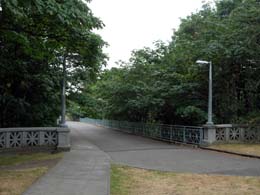In 1913, Seattle's Ravenna Park Bridge is constructed. A three-hinged, steel, lattice-arched bridge, it spans a deep ravine in Ravenna Park at 20th Avenue NE. Ravenna Park is a one-half-mile wooded ravine just north of the University District. The comely Ravenna Park bridge is designed by Frank M. Johnson under the direction of Seattle City Engineer Arthur Dimock.
The structure is 354 feet long. It has a 250-foot arch composed of two ribs (curved structural members that support a curved shape or panel) that rise 41 feet over the ravine, and support an 18-foot reinforced concrete roadway. The roadway is today reserved for pedestrian crossings only. Historians Holstine and Hobbs write that the bridge is "one of the finest legacies of Arthur Dimock's tenure as City Engineer" and that it is the oldest of only two steel lattice-arched spans (p. 159).
Ravenna Park was named by its original owner, W. W. Beck, when he acquired the land in 1889, because the place reminded him of Ravenna, Italy, a seacoast town graced with large pine trees. Other names for the park were Big Tree Park, Ravenna Springs, and Twin Maple Lane. The town of Ravenna was annexed to Seattle in 1907 and the city acquired the park land in 1911.

